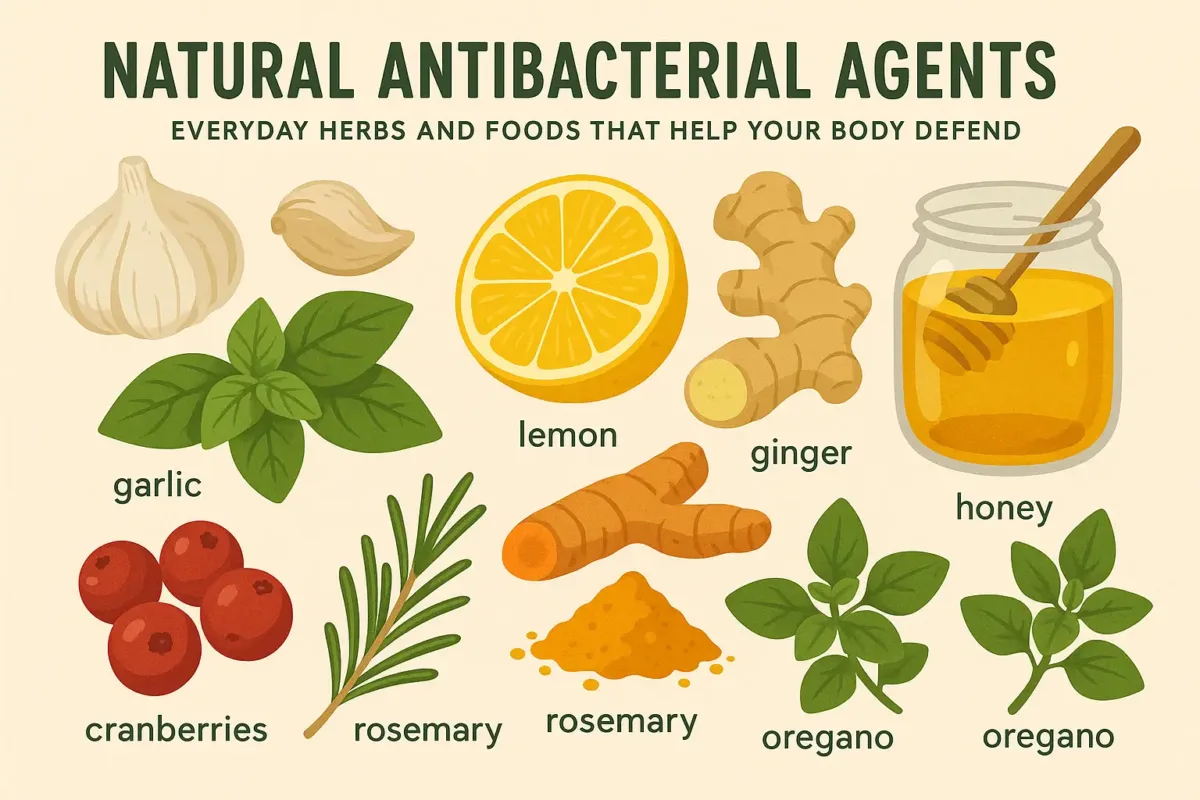Natural antibacterial agents don’t live only in medicine cabinets—they’re in your kitchen, herb garden, and spice rack. Long before the word “antibiotic” existed, people noticed that certain foods kept stews from spoiling, soothed infected cuts, and calmed sore throats. Today, research is catching up: compounds in garlic, honey, oregano, thyme, clove, cinnamon, turmeric, ginger, and more can meaningfully inhibit bacterial growth—especially on the surface of the body and in the mouth and gut. This guide simplifies the science, enabling you to utilize nature’s defenses in a wise, safe, and delicious manner.
- How Do Natural Antibacterials Work?
- Garlic: The Everyday Heavy Hitter
- Honey: Sweetness with Strategy
- Oregano & Thyme: The Mediterranean Shield
- Clove & Cinnamon: Sweet Spice, Serious Force
- Turmeric & Ginger: The Golden Duo
- Coconut Oil: Lauric Acid’s Quiet Work
- Herbal Teas & Acidic Tonics
- Antibacterial Eating: A Simple Daily Blueprint
- Skin, Mouth, and Gut: Where Natural Antibacterials Shine
- Biofilms: The Hidden Reason Some Problems Linger
- Quality, Dosage, and Safety Boundaries
- Myths to Retire (Gently)
- Emotional Terrain Matters
- Putting It All Together: A 7‑Day Antibacterial Kitchen Reset
- When to Stop Home Care and Seek Help
- FAQs
- What are the strongest natural antibacterial agents?
- Can natural antibacterials replace antibiotics?
- How do I use these agents safely?
- Which foods help daily?
- Do they affect gut bacteria?
- What about biofilms?
- Are essential oils necessary?
- Can kids use these remedies?
- Is manuka honey better?
- What’s one simple habit to start today?
How Do Natural Antibacterials Work?
Plants protect themselves from microbes using a tapestry of chemicals—terpenes, phenols, aldehydes, and organic acids. When we consume or apply these plants, we benefit from their protective properties. Unlike single‑target drugs, botanicals act on multiple pathways: disrupting bacterial cell walls, interfering with enzyme systems, lowering pH, dehydrating cells (as with honey), and breaking up biofilms (the slimy fortresses bacteria build to resist treatment). Because their action is “multi‑hit,” microbes tend to develop resistance more slowly.

There’s a catch: lab success doesn’t always equal real‑life dosing. The goal isn’t to swallow bottles of extracts but to build a consistent, food‑first pattern that keeps your body’s terrain less hospitable to trouble.
Garlic: The Everyday Heavy Hitter
When raw garlic is crushed, alliin and the enzyme alliinase combine to create allicin—a reactive sulfur compound that damages bacterial enzymes and weakens membranes. In vitro, allicin inhibits common culprits like Staphylococcus aureus and E. coli. In life, the best way to benefit is modest and steady: 1–2 raw cloves daily, added at the end of cooking or blended into dressings and dips. Waiting 10 minutes after chopping allows allicin to form. For throat comfort, a small spoonful of garlic‑honey after the mixture has rested can soothe without overwhelming digestion.
Honey: Sweetness with Strategy
Raw honey fights microbes through osmotic pressure (it dehydrates bacteria), acidity (pH ~3.2–4.5), and slow release of hydrogen peroxide. Manuka honey adds methylglyoxal (MGO), an extra antibacterial layer. A teaspoon in warm (not hot) lemon water coats irritated throats; medical‑grade honey dressings support clean healing in minor burns and superficial cuts. Pantry honey should not be used in deep or contaminated wounds; infants under one year should never consume honey due to botulism risk.
Oregano & Thyme: The Mediterranean Shield
These herbs contain carvacrol and thymol, phenols that punch holes in bacterial membranes and interfere with quorum sensing (how microbes coordinate). Culinary use is both safe and effective: add fresh oregano and thyme toward the end of cooking, simmer them in broths, or brew as tea. Essential oils are far stronger—if used topically, dilute to 0.5–1% and patch‑test; avoid internal use unless under professional guidance.
Clove & Cinnamon: Sweet Spice, Serious Force
Clove’s eugenol and cinnamon’s cinnamaldehyde show impressive antibacterial and antifungal activity, particularly in the mouth and gut. This is one reason spiced foods keep longer in hot climates. A clove‑cinnamon tea after meals may discourage problematic microbes while easing gas. For oral care, eugenol has a long history in dentistry—but concentrated oils can irritate tissues, so keep doses tiny and never apply undiluted to gums.
Turmeric & Ginger: The Golden Duo
Curcumin (turmeric) and gingerols/shogaols (ginger) don’t just fight microbes; they cool inflammatory pathways that make tissues vulnerable. Add turmeric with a pinch of black pepper (which boosts absorption) to soups and rice, and sip ginger tea for both digestion and defense. Together they steady the system—less inflammation, less opportunity for bacteria to take hold.
Coconut Oil: Lauric Acid’s Quiet Work
Virgin coconut oil contains lauric acid, which converts to monolaurin—a compound that disrupts lipid‑coated bacteria and some viruses. Oil pulling (swishing oil in the mouth for several minutes) may support oral hygiene; spit into the trash, not the sink. Culinary use is the simplest route: sauté vegetables in a spoonful or blend a teaspoon into warm drinks.
Herbal Teas & Acidic Tonics
Thyme, lemongrass, peppermint, chamomile, and sage teas provide mild antibacterial support while keeping tissues hydrated. Apple‑cider vinegar (ACV) lowers pH and extracts antimicrobial compounds from herbs; “fire cider”—an infusion of onion, garlic, horseradish, ginger, and chili in ACV—has been used for generations to wake up circulation and clear winter fog. Strain and dilute before sipping; a tablespoon in warm water is plenty.
Antibacterial Eating: A Simple Daily Blueprint
- Morning: Warm lemon water with honey; turmeric‑ginger tea mid‑morning.
- Lunch: Big salad with raw‑garlic vinaigrette and a sprinkle of oregano and thyme.
- Afternoon: Cinnamon‑clove tea or yogurt with honey.
- Dinner: Soup or stir‑fry finished with fresh garlic, ginger, and herbs.
- Weekly: Make a small jar of garlic‑honey and a batch of ACV fire tonic for the fridge.
The aim is rhythm, not heroics. Small, repeated exposures provide steady terrain support without stressing digestion.
Skin, Mouth, and Gut: Where Natural Antibacterials Shine
Skin: Honey dressings and diluted essential‑oil blends (tea tree + lavender at 1%) can support minor blemishes and superficial cuts. Avoid applying raw garlic to skin—it can burn. Mouth: Swishing with honey‑lemon water, coconut oil, or a diluted clove‑cinnamon rinse can nudge oral flora toward balance. Gut: Food‑level use of garlic, ginger, turmeric, and herbs encourages a healthier microbiome while avoiding the collateral damage of broad‑spectrum drugs.
Biofilms: The Hidden Reason Some Problems Linger
Biofilms are protective layers microbes build to shield themselves. Phenol‑rich herbs (oregano, thyme, clove) and certain enzymes can help disrupt these structures, making hygiene measures more effective. This is one reason people notice cleaner skin or fresher breath after adding small amounts of these spices consistently.
Quality, Dosage, and Safety Boundaries
- Choose whole foods first: culinary doses are the safest long‑term strategy.
- Respect potency: Essential oils are concentrates—always dilute and avoid internal use without guidance.
- Medical‑grade for wounds: Use sterilized honey dressings for open wounds and pantry honey for intact skin and tea.
- Allergies & meds: Garlic can interact with blood thinners; clove and cinnamon oils may irritate. When in doubt, ask a professional.
- Infants: No honey under one year. Be cautious with strong spices in young children.
Myths to Retire (Gently)
- “Natural equals harmless.” Nature’s pharmacy is powerful—dosage and dilution matter.
- “If a little helps, a lot cures.” Overuse can inflame skin and gut, eroding the very barriers that keep you well.
- “Herbs replace antibiotics.” They can prevent, soothe, and complement—but deep or systemic infections require medical care.
Emotional Terrain Matters
Chronic stress suppresses immune function, setting the stage for recurring issues. Aromatic herbs gently recruit the nervous system—warm teas, comforting soups, familiar scents—signaling safety and allowing repair. Healing isn’t only molecules; it’s messages.
Putting It All Together: A 7‑Day Antibacterial Kitchen Reset
This is not a diet; it’s a rhythm to invite resilience:
- Day 1: Stock garlic, raw honey, oregano, thyme, cinnamon, clove, ginger, turmeric, lemons, ACV.
- Day 2: Make garlic‑honey and ACV fire tonic. Brew a big pot of ginger‑turmeric tea.
- Day 3: Add oregano and thyme to lunch and dinner. Finish meals with clove‑cinnamon tea.
- Day 4: Try coconut oil for cooking and optional oil pulling in the morning.
- Day 5: Focus on oral care—diluted clove‑cinnamon rinse after brushing; honey‑lemon sip mid‑day.
- Day 6: Make a broth rich in garlic, ginger, turmeric; add greens and a squeeze of lemon.
- Day 7: Rest, hydrate, and write what worked. Keep the practices you enjoyed.
When to Stop Home Care and Seek Help
High fever, spreading redness, severe pain, shortness of breath, chest discomfort, or symptoms that persist or worsen require prompt medical evaluation. Natural strategies are most effective early and preventively; they are not substitutes for urgent care.
FAQs
What are the strongest natural antibacterial agents?
Garlic, oregano, thyme, clove, cinnamon, raw or medical‑grade honey, turmeric, and ginger are among the most researched.
Can natural antibacterials replace antibiotics?
No. They support prevention and mild, surface‑level issues. Serious infections need medical treatment.
How do I use these agents safely?
Favor food‑level doses; dilute essential oils; patch‑test skin applications; avoid honey for infants under one.
Which foods help daily?
Raw‑garlic vinaigrettes, ginger‑turmeric tea, oregano‑thyme seasoning, and a teaspoon of raw honey in warm water.
Do they affect gut bacteria?
They tend to nudge the microbiome toward balance without the broad wipeout seen with some drugs.
What about biofilms?
Phenol‑rich herbs like oregano and thyme may help disrupt biofilms when used consistently with good hygiene.
Are essential oils necessary?
No. Culinary herbs are often enough. If using oils, keep dilutions low and avoid internal use without guidance.
Can kids use these remedies?
Yes, in gentle, food‑level amounts. Avoid strong essential‑oil applications and honey for infants.
Is manuka honey better?
For wound dressings, medical‑grade manuka is helpful. For drinks and throat comfort, raw honey works well.
What’s one simple habit to start today?
Make a small jar of raw‑garlic vinaigrette and use a spoonful on lunch and dinner—easy, tasty, consistent.
Nature doesn’t hurry, and yet it heals. By weaving antibacterial herbs and foods into ordinary meals, you turn the kitchen into a quiet clinic—one that works with your body, not against it.
If this spoke to you, you’ll love the full information in this book; begin your deeper reading → See the book on Mayobook.


